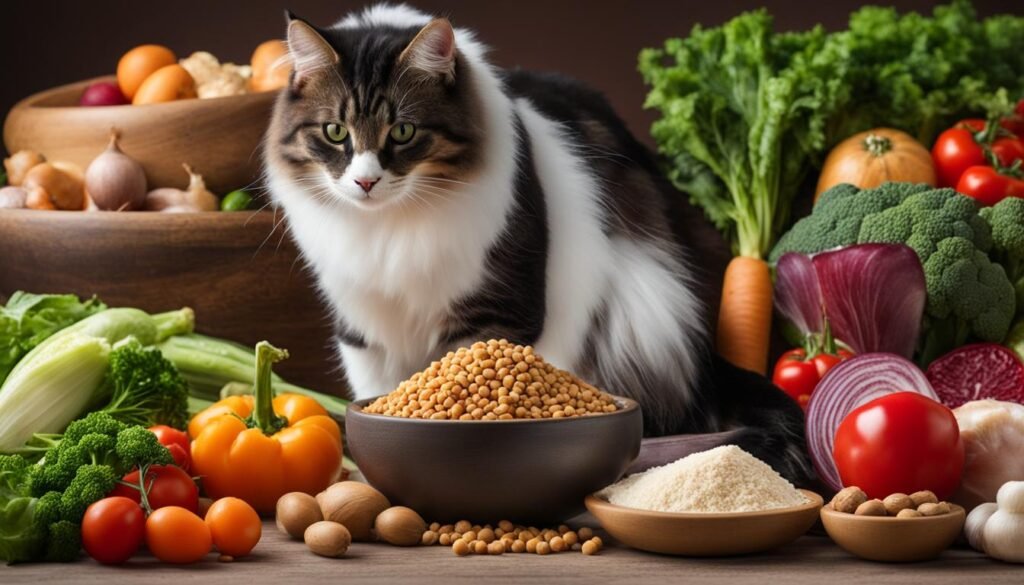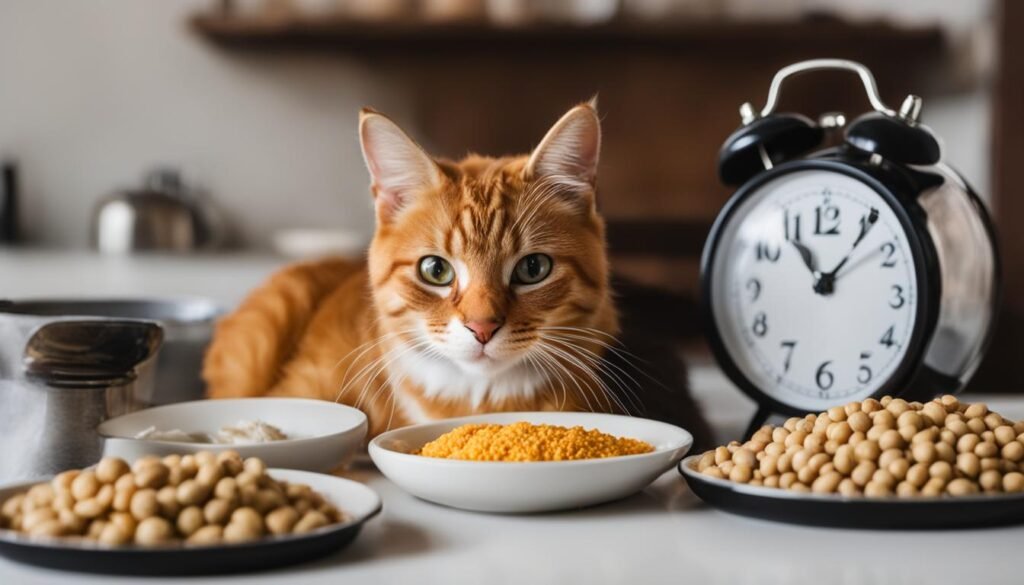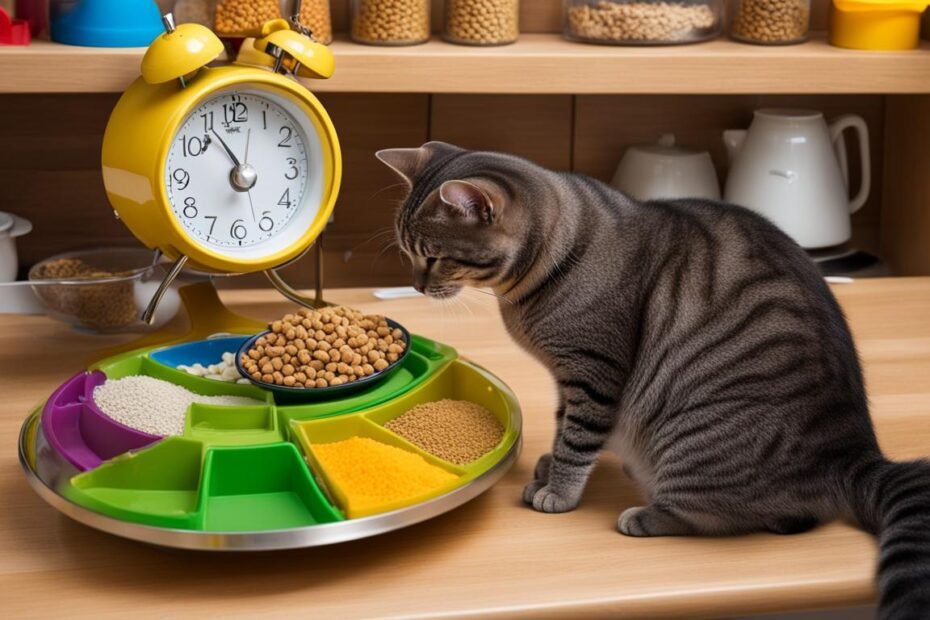Cats require a well-planned feeding schedule to ensure their health and happiness. Determining the right amount of food and how often to feed them can be challenging. Factors such as age, weight, body condition, and activity level all play a role in determining a cat’s dietary requirements. It’s important to establish a consistent feeding routine and monitor your cat’s weight and health to ensure they receive the proper amount of food. Consulting with a veterinarian can help determine the best feeding plan for your cat.
Key Takeaways:
- Determining the right feeding schedule is crucial for your cat’s health and happiness.
- Consider factors such as age, weight, body condition, and activity level when planning your cat’s diet.
- A consistent feeding routine helps monitor your cat’s weight and health.
- Consult with a veterinarian to create the best feeding plan for your cat.
- Transitioning from free feeding to a timed meal schedule can be done gradually.
Factors Affecting a Cat’s Dietary Needs
When it comes to feeding our feline friends, several factors come into play. Understanding these factors can help ensure that we meet our cat’s specific dietary needs for optimal health and well-being. Let’s explore the key factors that influence a cat’s dietary requirements.
1. Age: Just like humans, cats have different nutritional needs at various stages of life. Kittens require a higher calorie and nutrient-rich diet to support their rapid growth and development. Adult cats need a well-balanced diet to maintain their weight and overall health, while senior cats may require fewer calories due to reduced activity levels.
2. Weight and Body Condition: A cat’s weight and body condition are crucial factors in determining their dietary needs. Overweight cats may require portion control and a diet designed for weight management, while underweight cats may need more calorie-dense food. Regular monitoring of your cat’s weight and body condition is essential in adjusting their diet accordingly.
3. Activity Level: The level of activity your cat engages in also affects their dietary requirements. Highly active cats, such as those that spend time outdoors or engage in regular play, may need more calories and nutrients to fuel their energy levels. On the other hand, less active cats may need a diet with fewer calories to prevent weight gain.
Quick Tips:
- Consult with your veterinarian to determine the most suitable diet for your cat based on their age, weight, body condition, and activity level.
- Consider feeding your cat based on their specific dietary needs, such as weight management or a specialized diet for senior cats.
- Regularly monitor your cat’s weight and body condition to ensure they are maintaining a healthy weight.
By taking into account these factors, you can provide your cat with a balanced and tailored diet that meets their unique needs. Remember, every cat is different, so it’s important to consult with a veterinarian to create a feeding plan that is best suited for your furry friend.

Benefits of a Scheduled Feeding Routine
Implementing a scheduled feeding routine has numerous benefits for both you and your cat. It provides structure and routine for your furry friend, reducing stress and promoting healthy eating habits. By establishing set meal times, your cat knows when to expect food, creating a sense of security and predictability. This can be especially beneficial for cats who thrive on routine.
A scheduled feeding routine also allows you to control portion sizes easily, ensuring that your cat receives the appropriate amount of food for their age, weight, and activity level. This helps prevent overeating, which can lead to obesity and related health issues. It also allows you to monitor your cat’s appetite and detect any changes that may indicate illness or other health concerns.
In multi-pet households, a scheduled feeding routine can prevent competition for food and help you monitor each pet’s intake. This is particularly important if one of your pets requires a special diet or has specific nutritional needs. By feeding each pet separately and on a schedule, you can ensure that each one gets the appropriate food without any conflicts or issues.
Overall, a scheduled feeding routine can contribute to the overall well-being of your cat by providing structure, portion control, and the ability to monitor their appetite and health. It also creates a positive feeding experience for both you and your feline friend. Consider implementing a scheduled feeding routine and consult with your veterinarian to determine the best approach for your cat’s specific needs.
Transitioning from Free Feeding to Timed Meals
Transitioning your cat from free feeding to timed meals can be a beneficial change for their health and well-being. By implementing a structured feeding routine, you can help regulate their food intake and create a healthier eating habit. Here are some steps to successfully transition your cat:
- Establish a consistent feeding schedule: Determine the number of meals your cat should have each day and set specific times for feeding. This will help them adjust to the routine and prevent overeating.
- Designate a specific area for meals: Choose a quiet and comfortable area where your cat can enjoy their meals without distractions. This will help create a positive association with mealtime.
- Introduce a signal or cue: Use a consistent signal, such as ringing a bell or shaking a treat container, to let your cat know it’s time to eat. This will help them recognize and anticipate mealtime.
- Gradually reduce free feeding: Start by decreasing the amount of food available for free feeding while gradually increasing the portion size of timed meals. This will encourage your cat to rely on the scheduled meals for their food.
It’s important to be patient during the transition process. Cats may take some time to adjust to the new routine, so allow them to progress at their own pace. Consistency and positive reinforcement, such as praise or treats after meals, can help encourage their cooperation.

Automatic cat feeders can also be a helpful tool in transitioning to timed meals. These feeders can be programmed to dispense food at specific times, allowing your cat to eat even when you’re not at home. This can be especially useful for busy pet owners or those with unpredictable schedules.
Overall, transitioning from free feeding to timed meals can have numerous benefits for your cat’s health and well-being. It allows for better portion control, helps prevent overeating and obesity, and ensures that your cat is receiving consistent and balanced nutrition. If you have any concerns or questions during the transition process, consult with your veterinarian for guidance and support.
Pros and Cons of Scheduled Meals vs Free Feeding
Scheduled meals and free feeding each have their own advantages and disadvantages when it comes to feeding your cat. Here’s a closer look at the pros and cons of each method:
Scheduled Meals
Pros:
- Portion Control: With scheduled meals, you have better control over the amount of food your cat consumes, which can help prevent overeating and obesity.
- Routine: Establishing a feeding schedule provides structure and routine for your cat, promoting a sense of security and reducing stress.
- Monitoring: By feeding your cat on a schedule, you can easily monitor their appetite and detect any changes that may indicate illness or other health issues.
Cons:
- Time Constraints: Scheduled meals require you to be home at specific times to feed your cat, which may not always be feasible with a busy schedule or when traveling.
- Dependence: Cats can become dependent on the presence of their owner or the sound of food being prepared, making them anxious or demanding when meals are delayed.
- Less Freedom: Scheduled meals restrict your cat’s access to food, which may not align with their natural instincts to eat small, frequent meals throughout the day.
Free Feeding
Pros:
- Convenience: Free feeding allows your cat to have constant access to food, which can be convenient for busy schedules or multiple pets.
- Reduced Hunger: Cats have small stomachs and high metabolic rates, so free feeding can help alleviate hunger and prevent them from feeling anxious or stressed.
- Social Dynamics: In multi-pet households, free feeding can reduce competition for food and help maintain harmony among the pets.
Cons:
- Overeating: Cats may be prone to overeating when food is constantly available, leading to obesity and associated health issues.
- Difficult Monitoring: It can be challenging to monitor each cat’s individual food intake when free feeding, making it harder to identify any changes in appetite or health.
- Lack of Routine: Free feeding may result in irregular eating patterns, potentially causing digestive problems or creating difficulties in managing medication routines.
Ultimately, the decision between scheduled meals and free feeding depends on your cat’s specific needs, lifestyle, and your own preferences. Consider factors such as your cat’s weight, activity level, and ability to self-regulate their food intake. Consulting with your veterinarian can provide additional guidance and support in determining the best feeding method for your cat’s overall well-being.
Conclusion
In conclusion, establishing a cat feeding schedule is crucial for the overall well-being of your feline friend. By considering factors such as age, weight, and activity level, you can determine the appropriate amount and frequency of meals.
A scheduled feeding routine offers numerous benefits, including portion control, a structured routine, and the ability to monitor your cat’s appetite and health. It also helps prevent obesity and food-related aggression, particularly in multi-pet households.
If you currently free feed your cat, transitioning to timed meals can be done gradually, allowing your cat to adjust at their own pace. Automatic cat feeders can be a helpful tool when you’re unable to be home for meals.
Overall, it’s important to consider the pros and cons of scheduled meals versus free feeding, taking into account your cat’s specific needs and lifestyle. Consulting with a veterinarian can provide additional guidance and support in establishing a cat feeding schedule that promotes a happy and healthy feline companion.
FAQ
How do I determine the right amount of food to feed my cat?
Factors such as age, weight, body condition, and activity level play a role in determining a cat’s dietary requirements. Consulting with a veterinarian can help determine the best feeding plan for your cat.
What factors should I consider when determining my cat’s dietary needs?
Age, weight, body condition, activity level, and whether they are pregnant or nursing all play a role in determining a cat’s dietary needs.
What are the benefits of a scheduled feeding routine for my cat?
A scheduled feeding routine allows you to control portion sizes, provide structure and routine for your cat, and monitor your cat’s appetite and health.
How can I transition my cat from free feeding to a timed feeding routine?
Start by establishing a consistent feeding schedule, designating a specific area for meals, and gradually reducing the amount of food left out for free feeding while increasing the portion size of timed meals.
What are the pros and cons of scheduled meals vs free feeding?
Scheduled meals allow for portion control, routine, and monitoring of individual intake, while free feeding provides constant access to food but can lead to overeating and difficulties in monitoring intake.
Why is establishing a cat feeding schedule important?
Establishing a cat feeding schedule is essential for promoting a happy and healthy feline. It ensures they receive the proper amount of food and helps monitor their weight and health.
